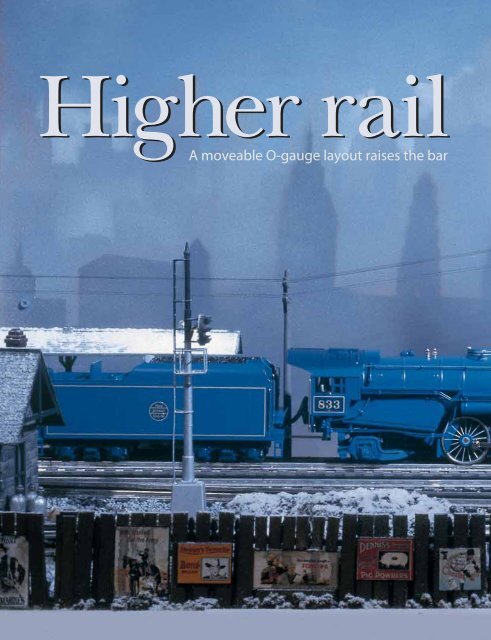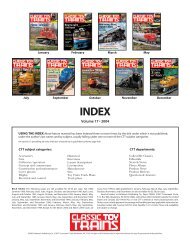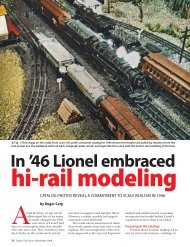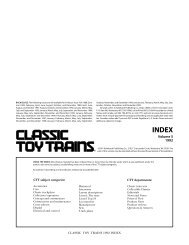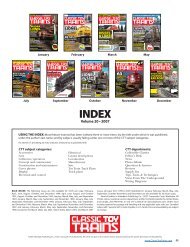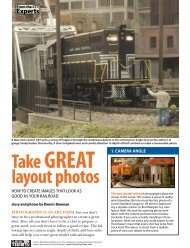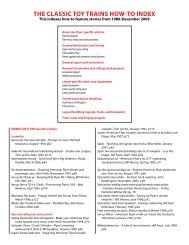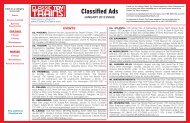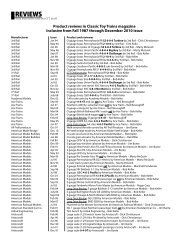A moveable O-gauge layout raises the bar - Classic Toy Trains
A moveable O-gauge layout raises the bar - Classic Toy Trains
A moveable O-gauge layout raises the bar - Classic Toy Trains
- No tags were found...
You also want an ePaper? Increase the reach of your titles
YUMPU automatically turns print PDFs into web optimized ePapers that Google loves.
y Rick Wright | photos by Paul DolkosMEMBERS OF <strong>the</strong> armed services,Pentagon employees andlocal HO and N scale modelrailroad enthusiasts descended into mybasement, where <strong>the</strong> pungent smell ofcoal smoke (lamp oil) is complementedby <strong>the</strong> unmistakable sound of flangedwheels on steel rails. Almost immediately,at <strong>the</strong> foot of <strong>the</strong> staircase, I couldsee <strong>the</strong>ir broad smiles break out beforean almost overwhelming visual andaudible spectacle.Welcome to <strong>the</strong> CONUS Lines, mywonderful world of O <strong>gauge</strong>, whererealism is all-important and where <strong>the</strong>scenes have a broad range of appeal.On this day, my guests see a Sou<strong>the</strong>rnPacific Cab-Forward labor upgrade,<strong>the</strong> sharp crack of its exhaust echoingoff granite walls. In its tow is a longstring of iced reefers heading east. On<strong>the</strong> outside main line, a Daylight 4-8-4leads a gleaming passenger train over adeep canyon and into a short tunnel,bound for a distant metropolis.On ano<strong>the</strong>r day, visitors might see apair of Conrail SD80MACs hustle a double-stackpriority intermodal manifestthrough a small town where passengersga<strong>the</strong>r for <strong>the</strong> pending arrival of <strong>the</strong>morning commuter train.1. An MTH Jersey Central Blue Comet passes Duffy’scoal yard on a cold morning. The scratchbuilt facilityincludes a modified Design Tech yard office.C LASSIC T OY T RAINS 51
Fur<strong>the</strong>r down <strong>the</strong> line, a pair ofChessie System GP38s leads an autoparts train in <strong>the</strong> shadow of a toweringrock formation known locally as“Devil’s Den.” Autumn corn standsready for <strong>the</strong> harvest.Continental by natureAll <strong>the</strong>se scenes, and many more,can be found on <strong>the</strong> CONUS Lines,a <strong>layout</strong> that has variably grown andcontracted over a 27-year period. Ithas endured 10 moves (including sixtranscontinental journeys) and nowexists, in its largest configuration yet,in Nor<strong>the</strong>rn Virginia as a 22 by 33-foot walk-around <strong>layout</strong> with two 14-foot peninsulas.CONUS is <strong>the</strong> U.S. Navy’sacronym for “Continental UnitedStates,” a designation that I feelserves as a particularly appropriatemoniker for my versatile railroad.I grew up in Cincinnati, Ohio,where seven Class I railroads operatedonly a bike-ride away from myhouse. Since <strong>the</strong>n, I’ve spent 28 yearsin naval service stationed fromAnnapolis to San Diego, to Newport,Rhode Island, to Norfolk, Virginia.Naturally, my railroad interests areeclectic; <strong>the</strong>refore, so is my approachto O <strong>gauge</strong> model railroading.It isn’t hard to figure out why Igave <strong>the</strong> railroad its slogan: “Anywhere,Anytime.” Conceptually, <strong>the</strong><strong>layout</strong> serves as a setting or stage fora wide spectrum of railroad experiences.By swapping motive power,rolling stock, selected structures,automobiles, and billboards, my <strong>layout</strong>can represent scenes in Americanrailroading anytime between 2. A tinplate accessory – <strong>the</strong> 74-year-oldLionel no. 437 signal tower, complete withknife switches on its back wall – looks surprisinglyat home next to an MTH Baldwin dieselin <strong>the</strong> Cumberland Yard section of RickWright’s CONUS Lines. 3. Remember Alfred Hitchcock’s film“North by Northwest”? That’s Cary Grant(modified from a Life-Like figure) running into<strong>the</strong> cornfield, made from dried cornhusks byRick’s wife. Just out of <strong>the</strong> photo is a 1:48 scalecrop duster chasing Grant.52 CLASSIC T OY T RAINS • N OVEMBER 2000
1930 and 2000 in <strong>the</strong> six geographicregions in which my family and Ihave lived: New England, Mid-Atlantic, South, Midwest, Far Westand Pacific Northwest. I’ve alsoincluded some Western Canada elementsto reflect great family days inVancouver and <strong>the</strong> canyons ofBritish Columbia where I’ve riddenand photographed trains.In addition to satisfying mydiverse interests, my generic <strong>layout</strong>also allows me to tailor settings andtrains to visitors’ particular favorites.For example, I once honored arequest from a former shipmate forhis fa<strong>the</strong>r to see “nothing butPennsy” on my <strong>layout</strong>. His broadsmile and evident pride (as a onetimePennsylvania RR employee)when he saw and heard an M1b westboundwith a brace of high carsmade me feel that my time andefforts were well spent.For visitors with more generalinterests (I can see upwards of 120 4. An SD80MAC leads an intermodal trainthrough Oakfield. Rick bought <strong>the</strong> scratchbuiltdepot and added it to a scene that includes aLionel no. 30 water tank and a Berkshire Valleytrain crew shed. 5. At Sierra Crossing, a worker ignores <strong>the</strong>considerable rumble of a Daylight GS-4 and aCab-Forward as he applies a coat of paint to aLionel no. 12770 arch-under bridge. Theneighboring thru truss and trestle bridges arescratchbuilt.people or more in a five-hourperiod), I provide a “call sheet” thatexplains <strong>the</strong> current session’s timeperiod and region and <strong>the</strong> trainsthat are running.A game of operationCONUS Lines’ raison d’être is <strong>the</strong>prototypical, realistic operation ofscale steam and diesel trains, with<strong>the</strong> additional center rail being <strong>the</strong>only significant difference from Oscale model railroading.The <strong>layout</strong> reflects my prior HOmodel railroading experience, withits inner main fully integrated withyard, industry and logging switchbackoperations. It can be run inN OVEMBER 2000 • CLASSIC T OY T RAINS 53
Building flatsSinclairgasFeed millCoal yardCUMBERLAND(town)1 6 2Depot8PRAIRIEVIEWLOGGINGSWITCHBACKCUMBERLAND(yard/industry)SIERRACROSSINGA&W4ButteCanyonDinosaurlandpark3CornfieldConus Lines“Anywhere, Anytime”scale: 3/8” = foot47OAKFIELD5DepotDevil's DenBy swapping motive power, rolling stock, selected structures, automobiles, andbillboards, my <strong>layout</strong> can represent scenes in American railroading anytime between1930 and 2000 in <strong>the</strong> six geographic regions in which my family and I have lived.illustration by Terri Fieldei<strong>the</strong>r continuous, point-to-point, orout-and-back fashion.My 118-foot double-track mainline, bi-directionally signaled, allowstwo trains to operate simultaneously.Meanwhile, I can perform switchingoperations in <strong>the</strong> yard and at localindustries, or I can negotiate <strong>the</strong>steep switchback grades to and from<strong>the</strong> logging camp at Spruce, where adozen tiny laborers have completedbackbreaking work to get it ready for<strong>the</strong> incoming train.Though I’m more of a realisticoperator than a toy train collector, Ididn’t want to exclude less realisticclassics from my <strong>layout</strong>. The outermainline is purposely isolated physicallyand electronically from <strong>the</strong> restof <strong>the</strong> <strong>layout</strong> to facilitate operationof a limited assortment of Lionel andAmerican Flyer prewar equipment.Big, but portableOne important design feature ofCONUS Lines is its portability. Acareer in today’s Navy carries with itonly one certainty: You will move,often, and not necessarily where orwhen you want. If you’re seriousabout model railroading, and don’twant to start from scratch every threeor four years or wait until you retire,you accept <strong>the</strong> temporary nature ofeach locale and design and build a<strong>layout</strong> accordingly.Each edition of CONUS Lines hasvaried in size and complexity,depending on how much time I hadto spend at sea during a particulartour of duty, and equally as important,what my pay grade was. Thebottom line: Shore duty and senioritymake for better, more complexand detailed <strong>layout</strong>s!One advantage to this approach isthat it has allowed CONUS Lines tostart small and grow throughout mynaval career. I’ve only had to buildtwo or three custom-cut connectingor corner modules at each new locationwhere I’ve lived.CONUS Lines, in its current configuration,is comprised of 33 2 by 4-foot modules and six custom-cut cornerand joiner sections. Thesesections are connected physically byC-clamps and electronically by sixpositioncinch sockets, eight-positionterminal strips, and RCA plugs.Each basic module is designed tostand alone. Thus, I can assemble a<strong>layout</strong> in “building block” or“domino” fashion to match <strong>the</strong> spaceavailable – from a 4 x 8-foot “table”<strong>layout</strong> in a small studio apartment inLong Beach in 1973, to my current54 CLASSIC T OY T RAINS • N OVEMBER 2000
configuration, <strong>the</strong> largest to date.When basements and largegarages weren’t available (as was <strong>the</strong>case in San Diego and VirginiaBeach), I’ve sometimes assembledCONUS Lines in <strong>the</strong> living room.(Obviously, I have an understandingand tolerant family!). O<strong>the</strong>r timesI’ve installed a number of sections ina large O <strong>gauge</strong> modular club <strong>layout</strong>in a local shopping mall.As far as <strong>the</strong> ordeal of moving, it’snever what I would call “fun.” However,as long as all <strong>the</strong> <strong>layout</strong>’s structuresand scenery details areremoved (a six-week process withplenty of long nights and help fromall family members), I can wrap <strong>the</strong>modules in heavy blankets for transportwith little damage.Seasons and scenesBecause CONUS Lines is meantto be visitor friendly, I kept <strong>the</strong> aislesbetween modules at least three tofour feet in width. That gives guestsroom to enjoy my particular emphasison <strong>the</strong> kinder, gentler aspects ofscale model railroading: realisticscenery and structures, and plenty ofpeople and animals. Despite my <strong>layout</strong>’sability to change settings, mostelements of scenery are relativelypermanent and offer even more varietyfor visitors who might enjoy achange in seasons.At present, all four seasons arerepresented in <strong>the</strong> 21st century versionof CONUS Lines. Springblooms on six modules comprising<strong>the</strong> whistle stop of Prairie View. Summershines in <strong>the</strong> four mountainmodules comprising Sierra Crossing.6. Snow has fallen on <strong>the</strong> lower level ofCumberland’s business district, which includesa Downtown Deco newsstand and <strong>bar</strong>ber shopand a Wal<strong>the</strong>rs Cornerstone building modifiedto create Yummie’s Donuts. Inside <strong>the</strong> donutshop, you might be surprised to find that <strong>the</strong>customers are regulars at Moe’s <strong>bar</strong> of TheSimpsons TV show fame, made possible by ascanned computer image.5 steps to hi-railWHAT IS O GAUGE hi-rail? The termis used often, but its exact meaningis sometimes open to debate.When I say “hi-rail,” I’m thinkingabout <strong>the</strong> definition I’ve read inRealistic Railroading with <strong>Toy</strong> <strong>Trains</strong>by Joe Lesser and Pete Youngblood(Greenberg Books, 1995).Hi-railing: A term used to denote toytrain operators who combine scale andnon-scale three-rail trains with a consciouseffort to achieve greater realism.With that definition in mind, Ioffer five easy steps you can take onyour <strong>layout</strong> to cross over into <strong>the</strong>world of O <strong>gauge</strong> hi-rail.1Slow down! Operate trains atprototypical speeds. The increasein realism is accentuated by soundsystems that reflect how fast <strong>the</strong>wheels are turning on a locomotiveand synchronous smoke systemswith prodigious smoke. Nothingimproves realism more than hearing,as well as seeing, a mammotharticulated laboring upgrade atclose to stall speed with a dozenhoppers, or a G-5 steam engineslowly accelerate a string of Madisoncars out of <strong>the</strong> station.2Wea<strong>the</strong>r everything. Granted,this is a lot easier to commit toon a $25 hopper than it is an $800Daylight, but you can at least apply alight application of Testor’s Dullcote(or a similar flat clear lacquer)to remove <strong>the</strong> shine. My favoritetechnique involves washes of paints.With an airbrush, I apply FloquilGrimy Black diluted 10-to-1 withDioSol (Floquil’s lacquer solvent) tomake that rolling stock look welltraveled. Grimy Black is also greatfor staining GarGraves wooden tiesand roadbed. Mixed with FloquilRoof Brown, it makes an excellentwea<strong>the</strong>r medium for virtually allstructures. Stay away from pureblacks, whites, and reds; a fewshades off <strong>the</strong>se traditional colorswill work wonders in achieving thatrealistic effect.3Match everything. You can “hirail”in scale-oriented 3-rail O<strong>gauge</strong> models, traditional O <strong>gauge</strong>models, and even O-27 models. Justdon’t mix <strong>the</strong> various pieces in atrain. A traditional Lionel no. 2055steam locomotive running down <strong>the</strong>main with a brace of 6464 boxcarslooks as “right” as a scale MTH PremierSP Cab-Forward with a longcut of Crown and Weaver woodsidedreefers. Remember: All thingsare relative!4Learn to love <strong>the</strong> color brown.Until <strong>the</strong> late 1960s, brown (invarious shades and hues) was <strong>the</strong>color of choice for most of <strong>the</strong>nation’s rolling stock. Hi-railing O<strong>gauge</strong>rs who favor <strong>the</strong> steam-todieseltransition period should alsofollow suit. Most color images ofthis era show long strings of freight,mostly in boxcars, in Freight CarRed, Tuscan, or Mineral Red, naturallywea<strong>the</strong>r worn and stained byuse. Bright colors sell models in <strong>the</strong>marketplace, but plenty of “brownish”models are available. And anairbrush and decals or dry transferscan do wonders for making a “correct”consist to run behind thosePennsy Centipedes you just bought!5Look, listen, and learn. Booksand videotapes can help youlearn more about realism, whe<strong>the</strong>rit is concerning equipment,scenery, operation, or <strong>layout</strong> design.The marketplace is full of how-tomodel railroading guides and colorphotoprototypebooks depicting aparticular railroad,era, or geographicregion. RealisticRailroading with <strong>Toy</strong><strong>Trains</strong> (where myhi-railing definitioncomes from), is myparticular favorite.For a more detaileddiscussion of myapproach to <strong>layout</strong>design and operation,read “DominoPlanning Basics,”an article by DavidHi-railing:A term used todenote toy trainoperators whocombine scale andnon-scale three-railtrains with aconscious effort toachieve greaterrealism.Barrow in Model Railroad Planning1999 (Kalmbach Publishing Co.).Videotaped reference sourcesinclude Allen Keller’s Great ModelRailroads series.I think you’ll find that <strong>the</strong>resources to add realism to toytrains are almost endless for <strong>the</strong>aspiring hi-railer. – Rick WrightN OVEMBER 2000 • CLASSIC T OY T RAINS 55
Autumn colors <strong>the</strong> railroad tanktown of Oakfield on three modules.Winter covers <strong>the</strong> 16 modules thatcomprise <strong>the</strong> city of Cumberlandand its adjoining yard, industry, andengine terminal facilities.I’ve included three loggingswitchback sections, which are notinterchangeable because of <strong>the</strong> varying(and very steep) grades involvedin <strong>the</strong>ir construction. The center ofswitchback operations is <strong>the</strong> smalldepot and water tank halfway up“<strong>the</strong> mountain,” where GP9s or shay56 CLASSIC T OY T RAINS • N OVEMBER 2000locomotives pause for a crew changebefore continuing <strong>the</strong> arduous climbto <strong>the</strong> logging camp at Spruce.Rails pass adjacent farmlands, exitdeep cuts and tunnels, and soar overbroad valleys. They connect fourprincipal scenes of activity populatedby 494 people, 39 dogs, nine squirrelsand a menagerie of deer, pigs,horses and cows.My wife Melly and daughters Jenniferand Carolyn, all enthusiasticsupporters of CONUS Lines, oftenwork on special construction projectsand provide suggestions for newvignettes, as well as that oft neededextra pair of hands. Our approach toscenery, particularly after repeatedvisits to <strong>the</strong> Choo-Choo Barn inStrasburg, Pa., provides differentvignettes every three feet, includingongoing highway repairs, railroadgandy dancers replacing ties, a loggingcamp replete with wood hicks(lumbermen), and a scratch-built logskidder and boom. This approachalways brings expressions of pleasureand surprise from visitors who
8. Rick dressed up a Lionel no. 12703 icingstation with scratchbuilt extensions and modicationsof <strong>the</strong> basic structure. A modifiedLionel no. 2318 control tower shares spacewith a Design Tech handcar shed and a GloorCraft Models coaling tower. 7. Think a change of scenery would do yougood? Rick is willing to accommodate. This singlescene at <strong>the</strong> end of Cumberland Yard cantake on three appearances by simply swappingstructures: <strong>the</strong> U.S. Envelope Co. (built fromDesign Preservation Models modules with ascratchbuilt roof); <strong>the</strong> under-constructionSunkist Citrus Warehouse (a project headed byRick’s wife, Melly); and Lamberts Point Coal Pierno. 5 and coal <strong>bar</strong>ge (scratchbuilt).wouldn’t know a New York CentralHudson from a Santa Fe Nor<strong>the</strong>rn.In fact, several repeat visitors atmy Christmas Season Open Houseeach year pride <strong>the</strong>mselves on discoveringwhich depictions are new.Two individuals have spent hourseach year counting people to see if<strong>the</strong> number I provide is “right.”The “big” questionNaturally, people always ask “Howlong did it take you to do all this?”and “How do you ever move all this?”However, one o<strong>the</strong>r often askedquestion, especially from fellowmodel railroaders, is “Why did youdecide to forego HO and get into OGauge hi-rail?”That question normally answersitself as <strong>the</strong> next mammoth steamlocomotive exits <strong>the</strong> deep cut nearOakfield, billowing clouds of smoke,its staccato exhaust synchronous withmassive drive wheels that lead a longcut of boxcars and hoppers to distantmarkets. To me, that sceneexplains <strong>the</strong> magic of O <strong>gauge</strong> hirail,particularly given today’sunprecedented degree of selectionand quality equipment.O <strong>gauge</strong> hi-rail is BIG stuff. Eventhough it’s technically less than twiceas large proportionately as HO scale,I like to think of it as eight times aslarge – twice as large in all threedimensions. It has a heft and feel toit that bespeaks “power.”Complementing O <strong>gauge</strong>’s sizeare <strong>the</strong> sight and sound system packagesavailable in today’s models,which add ano<strong>the</strong>r dimension ofrealism. Such features may help<strong>the</strong>se trains catch <strong>the</strong> attention ofpeople whose imaginations are jadedby television and computer screens.Perhaps, <strong>the</strong>n, <strong>the</strong>se people willcome to understand what was, and is,<strong>the</strong> splendor and unique appeal ofAmerica’s railroads.Yes, I still prize my Lionel no.2055 and O-27 starter set no. 1503WS that I received in <strong>the</strong> early 1950s.But realistic O <strong>gauge</strong> products introducedin <strong>the</strong> last decade represent,in nautical phraseology, a sea changein <strong>the</strong> hobby.Those inclined toward a scaleapproach, but still desirous of <strong>the</strong>pure enjoyment of model railroading,can have <strong>the</strong> best of both worlds.Realistic motive power and rollingstock can easily be combined with a“model railroading is fun” approachso all of us can remember and cherishour “classic toy trains.” TRick Wright will appear at <strong>the</strong> GreenbergShow at <strong>the</strong> Capital Expo Center inChantilly, Va., on December 30-31,2000. His presentation will focus on hisexpansive <strong>layout</strong> and its evolution over<strong>the</strong> years.N OVEMBER 2000 • CLASSIC T OY T RAINS 57
58 CLASSIC T OY T RAINS • N OVEMBER 2000


